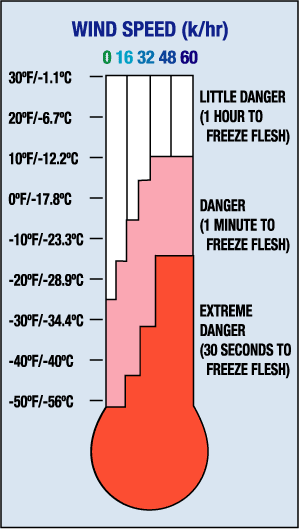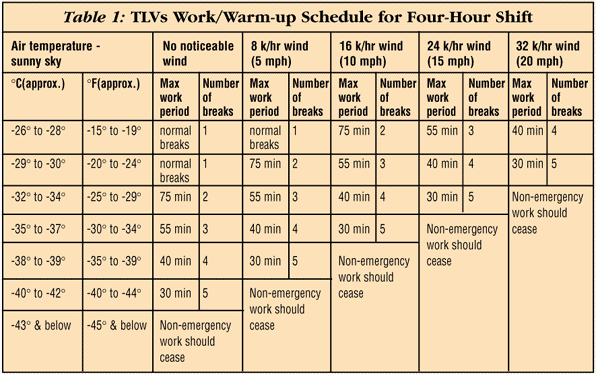Summary Statement
Describes risks of cold stress, symptoms of hypothermia and other cold stress issues and methods to avoid them.
Winter 2000/2001
Working in cold environments can involve health risks
|
Serious
cold-related illnesses and injuries may occur. |
Cold stress or hypothermia can affect construction workers who are not protected against cold. The cold may result naturally from weather conditions or be created artificially, as in refrigerated environments.
Cold is a physical hazard in many construction workplaces. When the body is unable to warm itself, serious cold-related illnesses and injuries may occur, leading to permanent tissue damage and even death.
Construction workplaces exposed to cold, wet, and/or windy conditions include
- roofs
- open or unheated cabs
- bridges or other projects near large bodies of water
- large steel structures that retain cold or are exposed to cold
- high buildings open to the wind
- refrigerated rooms, vessels, and containers.
This article provides information on
- effects of overexposure to cold
- factors that can worsen these effects
- control measures.
Knowing this information can help construction workers avoid hypothermia and frostbite.
CORE TEMPERATURE
The body tries to maintain an internal (core) temperature of approximately 37ºC (98.6ºF). This is done by reducing heat loss and increasing heat production.
Under cold conditions, blood vessels in skin, arms, and legs constrict, decreasing blood flow to extremities. This minimizes cooling of the blood and keeps critical internal organs warm. At very low temperatures, however, reducing blood flow to the extremities can result in lower skin temperature and higher risk of frostbite.
WIND-CHILL
Wind-chill involves the combined effect of air temperature and air movement. Wind-chill cooling rate is defined as heat loss (expressed in watts per meter squared) resulting from the effects of air temperature and wind velocity upon exposed skin. The higher the wind speed and the lower the temperature in the work environment, the greater the insulation value of the protective clothing required. Chart 1 compares the effects of air temperatures with and without wind. For example, when the air temperature is -28.9šC (-20šF) there is little danger of flesh freezing with no wind, increased danger with a wind of 8 km/h, and extreme danger with a wind of 32 km/h or more. When air speed and temperature produce a chill temperature of -32šC (-25.6šF), continuous skin exposure should not be permitted. Unprotected skin will freeze only at temperatures below -1šC (30.2šF), regardless of wind speed.

Chart 1: Wind-Chill Dangers
Adapted from TLVs® and BEIs®: Threshold Limit Values® for Chemical Substances and Physical Agents and Biological Exposure Indices®, American Conference of Governmental Industrial Hygienists, 1999.
When weather information is not available, the following signs may help to estimate wind speeds in the field:
- 8 km/hr (5 mph) light flag just moves
- 16 km/h (10 mph) light flag is fully extended by the wind
- 24 km/hr (15 mph) raises a newspaper sheet off the ground
- 32 k/hr (20 mph) wind capable of blowing snow.
|
Exposure
to cold causes two major health problems: hypothermia and frostbite. |
HYPOTHERMIA--signs and symptoms
When the body can no longer maintain core temperature by constricting blood vessels, it shivers to increase heat production. Maximum severe shivering develops when the body temperature has fallen to 35ºC (95ºF).
The most critical aspect of hypothermia is the body's failure to maintain its deep core temperature. Lower body temperatures present the following signs and symptoms:
- persistent shivering--usually starts when core temperature reaches 35ºC (95ºF)
- irrational or confused behavior
- reduced mental alertness
- poor coordination, with obvious effects on safety
- reduction in rational decision-making.
In addition, acute exertion in cold can constrict blood vessels in the heart. This is particularly important for older workers or workers with coronary disease, who may have an increased risk of heart attack.
HYPOTHERMIA--stages
Mild
Early signs of hypothermia include
- shivering
- blue lips and fingers
- poor coordination.
Moderate
The next stage includes
- mental impairment
- confusion
- poor decision-making
- disorientation
- inability to take precautions from the cold
- heart slowdown
- slow breathing.
Severe
In severe cases, hypothermia resembles death. Patients must be treated as though they are alive.
Symptoms of severe hypothermia include
- unconsciousness
- heart slowdown to the point where pulse is irregular or difficult to find
- no shivering
- no detectable breathing.
Stop further cooling of the body and provide heat to begin rewarming.
- Carefully remove casualty to shelter. Sudden movement or rough handling can upset heart rhythm.
- Keep casualty awake.
- Remove wet clothing and wrap casualty in warm covers.
- Rewarm neck, chest, abdomen, and groin--but not extremities.
- Apply direct body heat or use safe heating devices.
- Give warm, sweet drinks, but only if casualty is conscious.
- Monitor breathing. Administer artificial respiration if necessary.
- Call for medical help or transport casualty carefully to nearest medical facility.
|
Frostbite
is a common injury. |
FROSTBITE--signs and symptoms
Frostbite is a common injury caused by exposure to severe cold or by contact with extremely cold objects.
Frostbite occurs more readily from touching cold metal objects than from exposure to cold air. That's because heat is rapidly transferred from skin to metal.
The body parts most commonly affected by frostbite are face, ears, fingers, and toes. When tissue freezes, blood vessels are damaged. This reduces blood flow and may cause gangrene.
Frostbite symptoms vary, are not always painful, but often include a sharp, prickling sensation.
The first indication of frostbite is skin that looks waxy and feels numb. Once tissues become hard, the case is a severe medical emergency.
Severe frostbite results in blistering that usually takes about ten days to subside. Once damaged, tissues will always be more susceptible to frostbite in future.
FROSTBITE--first aid
- Warm frostbitten area gradually with body heat. Do not rub.
- Don't thaw hands or feet unless medical aid is distant and there is no chance of refreezing. Parts are better thawed at a hospital.
- Apply sterile dressings to blisters to prevent breaking.
- Get medical attention.
RISK FACTORS
Various medical conditions can increase the risk of cold injury:
- heart disease
- asthma/bronchitis
- diabetes
- vibration/white finger disease.
Check with your health practitioner to learn whether medications you are taking may have adverse effects in a cold environment.
|
Ensure
that wind-chill factor is understood by workers. |
CONTROLS
The best protection against cold-related health risks is to be aware and be prepared. Workers should recognize the signs and symptoms of overexposure in themselves and others. Pain in the extremities may be the first warning sign. Any worker shivering severely should come in out of the cold.
General
- Ensure that wind-chill factor is understood by workers, especially those working on bridges or out in the open on high buildings.
- Ensure that workers are medically fit to work in excessive cold, especially those subject to the risk factors highlighted above.
- Make sure that workers understand the importance of high-caloric foods when working in cold environments. Warm sweet drinks and soups should be arranged at the work site to maintain caloric intake and fluid volume. Coffee should be discouraged because it increases water loss and blood flow to extremities.
- Personnel working in isolated cold environments, whether indoors or outdoors, should have backup.
- Provide hot drinks and regular breaks under extremely cold working conditions.
Clothing
Select protective clothing to suit the cold, the job, and the level of physical activity.
- Wear several layers of clothing rather than one thick layer. Air captured between layers acts as an insulator.
- Wear synthetic fabrics such as polypropylene next to the skin because these whisk away sweat. Clothing should not restrict flexibility.
- If conditions are wet as well as cold, ensure that the outer clothing worn is waterproof or at least water-repellent. Wind-resistant fabrics may also be required under some conditions.
- At air temperatures of 2ºC (35.6ºF) or less, workers whose clothing gets wet for any reason must be immediately given a change of clothing and be treated for hypothermia.
- Encourage the use of hats and hoods to prevent heat loss from the head and to protect ears. Balaclavas or other face covers may also be necessary under certain conditions.
- Tight-fitting footwear restricts blood flow. Footwear should be large enough to allow wearing either one thick or two thin pairs of socks. Wearing too many socks can tighten fit and harm rather than help.
- Workers who get hot while working should open their jackets but keep hats and gloves on.

|
Encourage
workers to use shelters at regular intervals. |
Shelter
For work performed continuously in the cold, allow rest and warm-up breaks. Heated shelters such as trailers should be available nearby. Encourage workers to use these shelters at regular intervals depending on wind-chill factor.
Workers showing signs of shivering, frostbite, fatigue, drowsiness, irritability, or euphoria should immediately return to the shelter.
Workers entering the shelter should remove their outer layer of clothing and loosen other clothing to let sweat evaporate. In some cases, a change of clothing may be necessary.
EXPOSURE LIMITS
Ontario has no legislated exposure limits for work in cold environments. Table 1 was developed by the Saskatchewan Department of Labor and adopted by the American Conference of Governmental Industrial Hygienists (ACGIH). It indicates Threshold Limit Values (TLVs) for properly clothed personnel working at temperatures below freezing.
TRAINING
Before working in extreme cold, workers should be instructed in safety and health procedures.
Training should cover
- proper clothing and equipment
- safe work practices
- guidelines for eating and drinking
- risk factors that increase the health effects of cold exposure
- how to recognize signs and symptoms of frostbite
- how to recognize signs and symptoms of hypothermia
- appropriate first aid treatment, including rewarming procedures.
Adapted from Occupational Health and Safety Division, Saskatchewan Department of Labour
Notes
a) Schedule applies to any 4-hour work period of moderate-to-heavy work with warm-up periods of ten minutes in a warm location and with an extended break (e.g., lunch) at the end of the 4-hour work period in a warm location. For light-to-moderate work (limited physical movement) apply the schedule one step lower. For example, at -35ºC (-30ºF) with no noticeable wind (Step 4), a worker at a job with little physical movement should have a maximum work period of 40 minutes with 4 breaks in a 4-hour period (Step 5).
b) TLVs apply only for workers in dry clothing.
Hand Protection
Manual dexterity is essential to safety and production.
- Fine work performed with bare hands for more than 10-20 minutes in an environment below 16ºC (60.8ºF) requires special measures to keep workers' hands warm. These measures may include warm air jets, radiant heaters (fuel burning or electric), or contact warm plates.
- Metal handles of tools and control bars should be covered by thermal insulating material for temperatures below -1ºC (30.2ºF).
- Workers should wear gloves where fine manual dexterity is not required and the air temperature falls below 16ºC (60.8ºF) for sedentary, 4ºC (39.2ºF) for light, and -7ºC (19.4ºF) for moderate work.
- To prevent contact frostbite, workers should wear insulated gloves when surfaces within reach (especially metallic surfaces) are colder than -7ºC (19.4ºF). Warn workers to avoid skin contact with these surfaces.
- Tools and machine controls to be used in cold conditions should be designed for operation by gloved hands.



